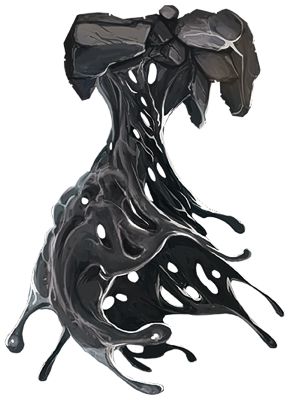

Monstrous Compendium Annual, Volume Two • The Ruins of Undermountain II

| Stone | Gray | Dense | |
|---|---|---|---|
| Pierre | Gris | Dense | |
| Climate/Terrain: | Subterranean | Subterranean | Subterranean |
| Frequency: | Rare | Uncommon | Rare |
| Organization: | Solitary | Solitary | Solitary |
| Activity Cycle: | Any | Any | Any |
| Diet: | Any | Any | Any |
| Intelligence: | Low (5) | Low (5) | Average (8-10) |
| Treasure: | Nil | Nil | Nil |
| Alignment: | Neutral evil | Neutral evil | Neutral evil |
| No. Appearing: | 1 (1-3) | 1 | 1 (1-4) |
| Armor Class: | 4 | 9 | 6 |
| Movement: | 3 | 9 | 6 |
| Hit Dice: | 5 | 10 | 10 |
| THAC0: | 15 | 11 | 11 |
| No. of Attacks: | 1 | 1 | 1 |
| Damage/Attack: | 3d6 | 4d8 | 4d8 |
| Special Attacks: | Moves on ceilings | Surprise, acid | Surprise, disease |
| Special Defenses: | See below | See below | See below |
| Magic Resistance: | 30% | 20% | 20% |
| Size: | L-H (8’+ diam.) | L-H (8’+ diam.) | L-H (8’+ diam.) |
| Morale: | Steady (11) | Steady (11) | Champion (15) |
| XP Value: | 1,400 | 3,000 | 4,000 |
Subterranean puddings are viscous, slimy creatures that resemble massive lumps more than living things. A subterranean pudding is, in fact, a colony of hundreds of living organisms in a single pudding. They have no visible eyes, ears, or mouths; the colony creature’s sensory organs are located on its underside. Subterranean puddings range from gray to deep blue in color and are usually 8 feet in diameter; larger masses indicate multiple puddings, though no more than four puddings are found in any one mass. They always search for food, moving along floors, ceilings, and walls to find prey.
Sages believe all subterranean puddings are magically altered black puddings. Indeed, the two monsters share some standard characteristics. Subterranean puddings take no damage from edged weapons; blunt weapons cause one-quarter normal damage, regardless of any magical bonuses. Such puddings are immune to acid, cold, and poison attacks. Unlike other puddings, they do not divide when attacked. Rather, they divide into two half-sized sections, each with full hit points, when any of the following spells are cast at them: fireball, lightning bolt, flamestrike, flaming sphere, wall of fire, chain lightning, and incendiary cloud.
Though malleable, this pudding appears rather solid and very sluggish. It is a thick lump that oozes slowly along any surface, preferring to hide on ceilings (from whence it can drop onto its food). It ranges in color from light gray to dark gray – the darker the color, the more recently it has fed. A stone pudding’s secretions are poisonous, and each attack causes 3d6 points of damage. When a pudding kills a victim, it rests upon the dead creature until its body absorbs the flesh. This takes 1-10 rounds. Stone puddings cannot eat metal, wood, leather, and other such objects, which are left behind after they consume their victims.
These puddings, their remains, and their surface secretions can be prepared as poisons and used as ingredients in oil of acid resistance.
Often mistaken for a stone pudding at a distance, this is perhaps the deadliest of the subterranean puddings. Gray pudding uses its deep gray coloration to blend in with shadows and the natural gray hue of stone. This gives its opponents a -4 surprise roll penalty. More corrosive than black pudding, the gray variety emits a powerful acid, delivering 4d8 points of damage. This acid eats through wood, leather, and chain mail in 1 round, and plate mail in 2. Each magical plus of an enchanted item adds 1 round to its survival time. In addition, the creature automatically delivers 4d8 points of damage each round it is encasing a victim. A creature reaching -10 hit points is dissolved, with not even a scrap of bone left behind.
Gray puddings are unusually susceptible to certain spells, provided those enchantments get past its magic resistance. These spells include flesh to stone, which acts as a slow spell on the pudding, and airy water, which alters the pudding’s form enough to drown it in its own fluid mass in 2d4 rounds.
This variety of subterranean pudding has 10 Hit Dice and is always found at its maximum hit point total (80 hp). Slower than gray pudding, the dense variety has learned from its “relatives” to cling to the shadows and use surprise to its advantage by dropping on potential meals. Targets suffer a -2 to their surprise rolls. Dense pudding is easy to spot in the open because of its dark blue coloration and large size.
The secretions of a dense pudding are corrosive only to living flesh and cause 2d10 hit points of damage. In addition, the secretions are tainted. All those who are damaged by a dense pudding must make a successful saving throw vs. poison or succumb to a debilitating disease. Cure disease will negate these effects if cast within 48 hours of the infection.
